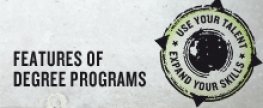
Apply
now
now
Mathematics 2
level of course unit
First cycle, BachelorLearning outcomes of course unit
Students are able to translate an economic or engineering problem into the language of mathematics in simple cases. To draw conclusions from the mathematical models obtained with suitable mathematical methods and finally to translate these conclusions back into statements about the original problem formulated in everyday language.
prerequisites and co-requisites
not applicable
course contents
Differential calculus in several variables: Extreme value tasks with and without constraints
technical applications, nonauthentic integrals, numerical integration
Complex numbers and functions
Important differential equations (DGI):
General information about linear and nonlinear DGI, DGI 1st order with separated variables, linear DGI 1st order with constant coefficients and technical applications, linear DGL 2nd order with constant coefficients and vibration problems
technical applications, nonauthentic integrals, numerical integration
Complex numbers and functions
Important differential equations (DGI):
General information about linear and nonlinear DGI, DGI 1st order with separated variables, linear DGI 1st order with constant coefficients and technical applications, linear DGL 2nd order with constant coefficients and vibration problems
recommended or required reading
• Papula (2011): Mathematik für Ingenieure und Naturwissenschaftler, Band 1, 13. Aufl., Vieweg+Teubner Verlag Wiesbaden
• Papula (2011): Mathematik für Ingenieure und Naturwissenschaftler, Band 2, 13. Aufl., Vieweg+Teubner Verlag Wiesbaden
• Papula (2011): Mathematik für Ingenieure und Naturwissenschaftler, Band 3, 6. Auflage.- Vieweg+Teubner Verlag Wiesbaden
• Schwarze (2010): Mathematik für Wirtschaftswissenschaftler - Band 1: Grundlagen, 13. Aufl., NWB Verlag Herne
• Schwarze (2010): Mathematik für Wirtschaftswissenschaftler - Band 2: Differenzial- und Integralrechnung, 13. Aufl., NWB Verlag Herne
• Schwarze (2010): Mathematik für Wirtschaftswissenschaftler - Band 3: Lineare Algebra, Lineare Optimierung und Graphentheorie, 13. Aufl., NWB Verlag Herne
• Schwarze (2003): Mathematik für Wirtschaftswissenschaftler – Elementare Grundlagen für Studienanfänger, Kapitel 1 bis 10, 7. Aufl., NWB Verlag Herne
• Stingl (2009): Mathematik für Fachhochschulen: Technik und Informatik, 8. Aufl., Carl Hanser Verlag München
• Tietze (2000): Einführung in die Angewandte Wirtschafts-Mathematik, 9. Aufl., Vieweg+Teubner Verlag Wiesbaden
• Janssen, Laatz (2007): Statistische Datenanalyse mit SPSS für Windows, 6. Aufl., Springer Verlag Berlin
• Brosius (2002): SPSS 11, Verlag Moderne Industrie Bonn
• Bourier (2014): Beschreibende Statistik: Praxisorientierte Einführung, 12. Aufl., Springer Gabler Verlag Wiesbaden
• Jeske (2003): Spaß mit Statistik: Aufgaben, Lösungen und Formeln für Statistik, 4. Aufl., Oldenbourg Wissenschaftsverlag München
• Mosler, Schmid (2008): Wahrscheinlichkeitsrechnung und schließende Statistik, 3. Aufl., Springer Verlag Berlin
• Mosler, Schmid (2009): Deskriptive Statistik und Wirtschaftsstatistik, 4. Aufl., Springer Verlag Berlin
• Papula (2011): Mathematik für Ingenieure und Naturwissenschaftler, Band 2, 13. Aufl., Vieweg+Teubner Verlag Wiesbaden
• Papula (2011): Mathematik für Ingenieure und Naturwissenschaftler, Band 3, 6. Auflage.- Vieweg+Teubner Verlag Wiesbaden
• Schwarze (2010): Mathematik für Wirtschaftswissenschaftler - Band 1: Grundlagen, 13. Aufl., NWB Verlag Herne
• Schwarze (2010): Mathematik für Wirtschaftswissenschaftler - Band 2: Differenzial- und Integralrechnung, 13. Aufl., NWB Verlag Herne
• Schwarze (2010): Mathematik für Wirtschaftswissenschaftler - Band 3: Lineare Algebra, Lineare Optimierung und Graphentheorie, 13. Aufl., NWB Verlag Herne
• Schwarze (2003): Mathematik für Wirtschaftswissenschaftler – Elementare Grundlagen für Studienanfänger, Kapitel 1 bis 10, 7. Aufl., NWB Verlag Herne
• Stingl (2009): Mathematik für Fachhochschulen: Technik und Informatik, 8. Aufl., Carl Hanser Verlag München
• Tietze (2000): Einführung in die Angewandte Wirtschafts-Mathematik, 9. Aufl., Vieweg+Teubner Verlag Wiesbaden
• Janssen, Laatz (2007): Statistische Datenanalyse mit SPSS für Windows, 6. Aufl., Springer Verlag Berlin
• Brosius (2002): SPSS 11, Verlag Moderne Industrie Bonn
• Bourier (2014): Beschreibende Statistik: Praxisorientierte Einführung, 12. Aufl., Springer Gabler Verlag Wiesbaden
• Jeske (2003): Spaß mit Statistik: Aufgaben, Lösungen und Formeln für Statistik, 4. Aufl., Oldenbourg Wissenschaftsverlag München
• Mosler, Schmid (2008): Wahrscheinlichkeitsrechnung und schließende Statistik, 3. Aufl., Springer Verlag Berlin
• Mosler, Schmid (2009): Deskriptive Statistik und Wirtschaftsstatistik, 4. Aufl., Springer Verlag Berlin
assessment methods and criteria
Written exam
language of instruction
Germannumber of ECTS credits allocated
4eLearning quota in percent
15course-hours-per-week (chw)
3planned learning activities and teaching methods
Integrated course







